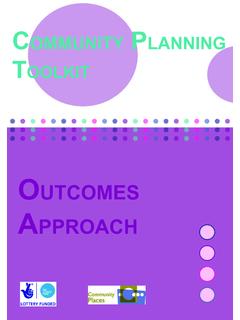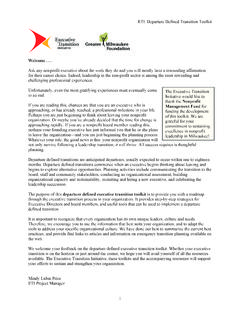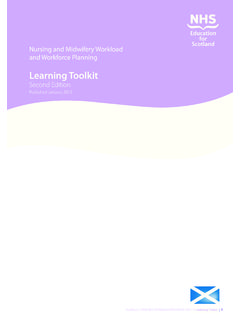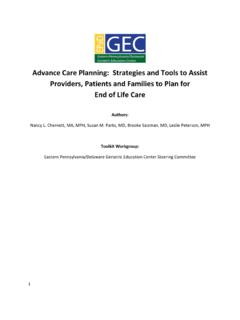Transcription of Community Planning toolkit
1 CommunityEngagEmEntCommunity Planning toolkitCommunity Planning toolkit - Community EngagementDeveloped by Community Places through the support of the BIG Lottery Planning toolkit - Community Engagement1. Introduction This section of the toolkit provides guidance on the issues to consider when Planning and designing Community engagement. It focuses on quality and effectiveness, process Planning and designing engagement tailored to the particular issue, level of participation to be achieved, timeframe and range of stakeholders Planning and Designing Community Engagement Community engagement works best where it is an ongoing cumulative process enabling relationships and trust to build and strengthen over time. Individual engagement events should be planned and designed with this in mind and aim to contribute to the overall aims of the engagement process. Community or voluntary groups may want to participate at a range of levels from providing advice to co-designing the process and from undertaking some aspects of the engagement to delivering projects to meet some of the outcomes.
2 Thinking through the following questions and issues will help in the Planning and design of Community engagement. What level of participation is it hoped will be achieved? How to identify the stakeholders? Communications. Stage of the engagement process. Resources. Are there any limitations? Timely feedback and next steps. Tools to help choose a method. is the purpose and scope of the engagement process?From the outset be clear about the scope and purpose of the engagement process. For example, is the process designed to: Identify or prioritise what the needs and priorities for Community Planning should be? Develop a consensus on a proposal or plan? Inform the decision-making or service delivery of a Community , council or department? Develop new or collaborative ways of implementing elements of the Community Plan? Review progress on the Community Plan? Agreeing a clear purpose will help identify engagement objectives, anticipated outcomes and help to determine the scope and depth of the engagement.
3 This can range from consultation to involvement in decision making through to Community and voluntary groups delivering projects and services. Providing information on proposals, plans or services is part of any communication plan to support engagement but is not in itself Community engagement. Often communities will need Contents1. Introduction 032. Planning and Designing 03 Community Engagement3. Quality Standards for Community 07 Engagement4. Online Tool to Guide Engagement 08 Activity - VOiCE5. Tools to Help to Choose a 08 Method(s)6. Methods and Techniques 097. Resources 244 Community Planning toolkit - Community EngagementUsers and Beneficiaries of the activities and funds of the partnership. This is the most basic level of engagement. Advisers to the partnership through their involvement in consultations, working parties and evaluations which seek their guidance and to Management through membership of forums and steering groups that work alongside staff supervising progress on partnership Makers primarily through their membership of the partnership board, but also when periodic consultations are taking place about strategic choices and other major of projects and programmes on behalf of the partnership and as local successor bodies that are being developed to take over projects and programmes from the 1: Five Roles for the Community R1 Community Participation Community Development Plan (2008, ) identify another way of thinking about different levels of support to help them engage meaningfully.
4 The Community and Voluntary Sectors (CVS) are skilled in providing this support but may need access to resources to do level of participation are you hoping to achieve? Community stakeholders can participate in a variety of ways, and to different levels of influence, in identifying needs, generating solutions, Planning new initiatives and service delivery as illustrated in the diagram below:In Dundee, each of the 8 local Community plans, which are developed by local Community Planning partnerships, sets out a Community Engagement Action Plan. The Action Plan aims to raise the levels and quality of participation at the local level and encourage local communities to identify and address issues and concerns through the Community Planning process Identifying stakeholders Every Community will be made up of a range of stakeholder interests. These might include: Local Residents or Area Based Groups Communities of Interest Faith Based Groups Racial, Ethnic and Cultural Groups Local Community and Voluntary Groups Web Based or Virtual Groups It will be essential to utilise a range of mechanisms and avenues to facilitate the widest possible participation from these interests.
5 Local Community development networks and support organisations should be involved in identifying Community stakeholders, their particular interests and needs and how best to engage with them. Issues to consider include: What impact the issue or proposals will have on these stakeholder interests? Who represents these interest groups? Are there existing Community networks or forms of communication? Are there gaps in information which could be plugged through local knowledge? The relevant Equality InformedConsultationBeing AskedCommenting on DecisionsEngagementDeveloping SolutionsDelivering ServicesPartnershipR25 Community Planning toolkit - Community EngagementInclusiveness: Overcoming Barriers to engagement When Planning an engagement process you need to recognise diversity, identify any potential barriers and design the process to minimise barriers where possible. How (not) to exclude? provides a useful resource. Potential Barriers to consider Design Issues to consider The capacity and ability of different stakeholders to participate Hard to reach groups such as young people, older people, minority groups or socially excluded groups Levels of Community infrastructure Contested or divided communities Rural isolation Gaps in information Literacy and numeracy levels and dominance of oral culture Techniques and engagement methods to be used Need for independent facilitation Location and accessibility of the venue The number and type of engagement events Transport requirements Childcare needs Format and content of communication and publicity materials Use of interpreters and signers Need for outreach activitiesThe stage of the engagement process?
6 It is important to consider at what stage of the engagement process you are and how each stage or event contributes to the aims of the overall engagement - different forms of communication, information and engagement methods will be more appropriate depending on the stage of your engagement Communication materials should be jargon free and in plain English; available in accessible formats and provided in alternative language(s) as appropriate. Given the strong oral tradition in many communities events where individuals can discuss the issues first hand are invaluable. In order to maximise levels of participation communication materials should use clear examples or case studies of how the issue or proposed plan is likely to affect different individuals and sections of society. Use existing Community networks and forms of communication to publicise events and identify opportunities to align or hold combined events for greater impact. R36 Community Planning toolkit - Community EngagementWhat Time and Resources are available?
7 The following types of resources will be required for most forms of engagement: Input by staff, volunteers and other interested stakeholders; Background information or briefing papers on the issue(s) or plan proposals; Independent facilitation; Communication and promotion, venue hire, transport, childcare, translation; Printing and circulating a report on the output of the process and for provision of feedback; Resourcing local Community and Voluntary groups to (for example and where appropriate) support people in understanding and responding to information and proposals; commission research; convene meetings; prepare papers, reports or You should be clear and explicit about what you understand the limitations to be, such as time constraints, finances and resources available. Are some issues not up for discussion - for example, legislative framework, decisions taken already, confidential information or available budgets and resources? Some of these stated limitations may be challenged and you should be prepared to explain why they exist.
8 Timely Feedback and Next Steps Participants in any one stage of engagement should be informed of or offered the opportunity to shape the next stages of the overall engagement process. In particular information will be required on: How and when feedback will be provided; Other elements or strands of the engagement process; How and when decisions will be taken; Further opportunities for engagement; and Whether Community /voluntary groups can be involved at the implementation stage. This will help to reinforce participation and encourage stakeholders to continue to be active as the engagement evolves. It is also important to communicate during feedback on how stakeholder input has influenced, contributed to or improved the overall engagement within the ProcessPlanning for flexibility is essential the context may change, stakeholders may challenge the purpose of the process, question the scope of the objectives or the methodology or require more information, time or their own resources to co-design the process.
9 The overriding consideration should be retaining and developing meaningful engagement with stakeholders. EvaluationIt is critical that any engagement process is evaluated on both an ongoing basis and post-completion. Evaluation will provide valuable feedback for example, on the best methods for engaging with groups in a particular area or the most appropriate times or venues. These findings should inform your future engagement processes. 7 Community Planning toolkit - Community Engagement3. Quality Standards for Community Engagement The 10 National Standards for Community Engagement The Scottish National Standards for Community Engagement provide a very useful reference point for ensuring a quality and effective engagement process. They were published in 2005 by the then Minister for Communities and identify good practice for engagement between communities and public agencies. The Scottish Community Development Centre (SCDC) developed the standards drawing on the experience of over 500 Community and agency representatives.
10 The SCDC website contains a detailed description of the standards and other useful resources. R4 and R5 The 10 Standards are: 1. The Involvement StandardWe will identify and involve the people and organisations with an interest in the focus of the The Support StandardWe will identify and overcome any barriers to The Planning StandardWe will gather evidence of the needs and available resources and use this to agree the purpose, scope and timescale of the engagement and the actions to be The Methods Standard We will agree the use methods of engagement that are fit for The Working Together StandardWe will agree and use clear procedures to enable the participants to work with one another efficiently and The Sharing Information StandardWe will ensure necessary information is communicated between the participants. 7. The Working With Others StandardWe will work effectively with others with an interest in the engagement. 8. The Improvement Standard We will develop actively the skills, knowledge and confidence of all the The Feedback StandardWe will feedback the results of the engagement to the wider Community and agencies The Monitoring and Evaluation Standard We will monitor and evaluate whether the engagement meets its purposes and the national standards for Community engagement.









